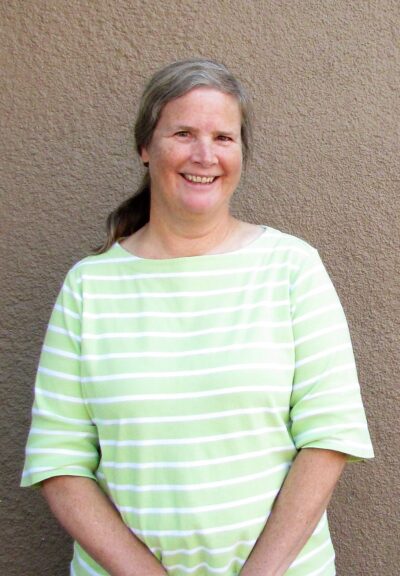Forty-five seconds. That’s all the time Jonna and Tony Mendez needed to swap disguises and evade KGB spies. As the CIA’s Chiefs of Disguise during the Cold War, the Mendezes could pull off these miraculous transformations while walking down the street in broad daylight. Jill Colburn-Bernard works in similar ways at the Adult Education Center.
First, as the HSE Resource Coordinator, Jill wears many different hats in order to muster the tools and supports students need to reach graduation with a high school equivalent (HSE) diploma. Second, she operates much like a covert CIA agent, sneaking around the obstacles that would otherwise hinder a student’s success in the classroom.
“I oversee Aztec Software, our online GED study program,” Jill explains. “[HSE] students can use this tool to supplement their classwork. We also have a handful of students who are unable to attend classes in person. I partner with these students as they navigate distance learning. I monitor their study time, as well as their drills and tests scores, to determine when they might be ready to test.”

Jill Colburn-Bernard, HSE Resource Coordinator
Jill also coordinates tutors for GED students. She notes, “When a student requests a tutor, I find a good match and then lend my support. This support mainly involves locating tutoring materials. Our tutors are incredibly talented at then taking those materials and running with them. I wait in the wings—watching the magic—and then lend a hand when needed.”
Accessible Design Coordinator is another of Jill’s professional hats. In that role, she sees to the specific needs of students who disclose a documented learning difference or disability.
“These challenges may be educational, physical, social/emotional…anything that might make earning a GED daunting,” Jill says “Once a student discloses a need and gives me permission to share that need with our staff, we form a team and create a learning plan. Our teachers are stellar at accommodating individual needs of all the students in their classrooms. I focus more on how I can further support the student beyond the daily classwork.”
For instance, if a student needs more time to read and process information, Jill will help them get an extended time accommodation for their GED tests. Acquiring an exception to the typical time limit is complicated and involves a lot of paperwork. Jill helps students send in the correct documentation to the GED testing authorities.
Jill has to consider factors far trickier than more time. “Black words on a white background may pose problems for someone with dyslexia or Irlen Syndrome,” Jill explains. “Perhaps a blue background is better. I can show students all the color and size combinations GED offers [on the digital test platform] so that they know going in how to adjust their screens to best meet their visual needs.”
Although she is adept at finding solutions, Jill admits that not all students are comfortable disclosing unique learning conditions.
“It takes great courage for a student to disclose a disability,” she says. “Unfortunately, many people view a learning disability as equating to low ability when, in actuality, it’s often tied to unique mental processing styles. My job is to help our students shed the disability ‘stigma’ they may have felt in their previous school experience. It’s rewarding, for me and the student, when they realize that they possess great ability and just need to discover the best way to unlock it.”
Under still more hats, Jill is available to work with any student specifically on test-taking strategies. She operates as a kind of page and maven among her coworkers, helping them tackle big projects or clean items off their long to-do lists. Sometimes, she lends powerful insights to solve a problem; other times, she simply steps in to help make copies or file paperwork. “Substitute teacher” is yet another of her “disguises,” which enables to her to fill in when a teacher is absent.
Teaching has always been Jill’s passion.
“I was born an educator!” She beams. “As a child, I would often ‘play school.’ I was always the teacher, and my student was frequently my unfortunate (but good sport) younger brother.”
After graduating with a teaching certificate from Fort Lewis College, Jill spent the next 26 years teaching for Durango 9-R across many grade levels. She points out, “The last 10 years, I spent teaching K-5 Gifted Education at several of the elementary schools in the district. I partnered with all the K-12 Gifted Ed. Facilitators—sometimes designing opportunities for the middle and high school students to work with the elementary students. I found that I really enjoyed working with older students. This opened my eyes to the possibility of the wonderful world of adult education!”
Once Jill had retired from teaching in the public schools, a friend and fellow teaching retiree recommended Jill look at opportunities at the Adult Education Center.
As Jill explains it, “I applied, was hired, and can’t imagine working elsewhere! I delight in the diversity of all our students. I feel that between our high school equivalent and English as a Second Language students, the AEC is a microcosm of the world. We live on a very diverse planet. Being able to spend time with others from different cultures, beliefs and experiences is a gift. I believe it makes us better human beings. I know working at this school has caused me to grow. I’m grateful to work somewhere that reflects our big, beautiful world.”
This perspective best encapsulates Jill’s biggest, most important covert wardrobe change in her day-to-day operations. In essence, it’s not the number of hats she dons, but rather the vast number of shoes she can step into. This skill enables Jill to best understand all students at the AEC and, in turn, better serve their learning.
Coupling outstanding teachers with innovative resource coordination and accessibility services has produced top marks for the Center. So far in 2022, the AEC’s students exceeded Colorado’s target for measurable skills gained in the classroom. And, the majority of its GED students passed their subject tests with college-ready scores.
“The AEC embodies what I always thought education should look like,” Jill says. “I love being part of a team that views all our students as individuals with unique needs. Every one of us learns at different rates, interprets information differently based on our prior experiences, draws a variety of conclusions, problem-solves using different methods and—maybe even most importantly—have different personal needs that must be met before learning can take place.”
Featured image: Spy vs…? by Theodore Lee CC BY-NC-ND 2.0



